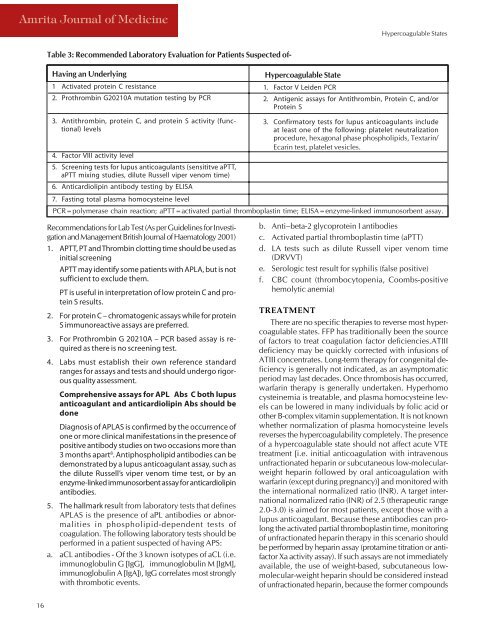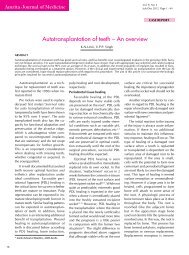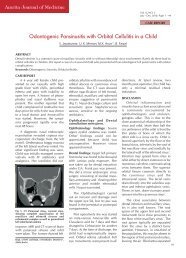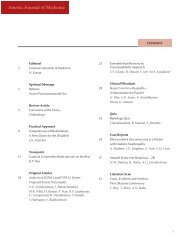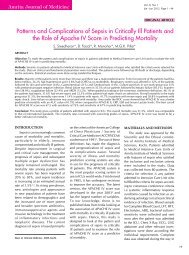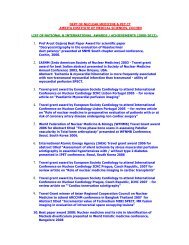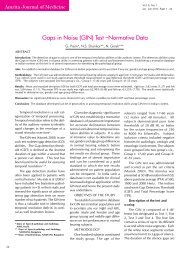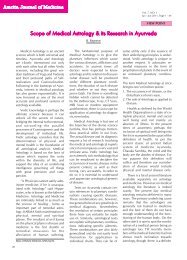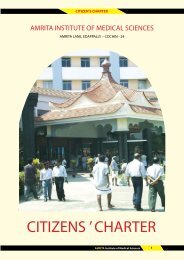Journal of Medicine Vol 2 - Amrita Institute of Medical Sciences and ...
Journal of Medicine Vol 2 - Amrita Institute of Medical Sciences and ...
Journal of Medicine Vol 2 - Amrita Institute of Medical Sciences and ...
Create successful ePaper yourself
Turn your PDF publications into a flip-book with our unique Google optimized e-Paper software.
<strong>Amrita</strong> <strong>Journal</strong> <strong>of</strong> <strong>Medicine</strong><br />
Hypercoagulable States<br />
Table 3: Recommended Laboratory Evaluation for Patients Suspected <strong>of</strong>-<br />
Having an Underlying<br />
1 Activated protein C resistance<br />
2. Prothrombin G20210A mutation testing by PCR<br />
Hypercoagulable State<br />
1. Factor V Leiden PCR<br />
2. Antigenic assays for Antithrombin, Protein C, <strong>and</strong>/or<br />
Protein S<br />
3. Antithrombin, protein C, <strong>and</strong> protein S activity (functional)<br />
levels<br />
3. Confirmatory tests for lupus anticoagulants include<br />
at least one <strong>of</strong> the following: platelet neutralization<br />
procedure, hexagonal phase phospholipids, Textarin/<br />
Ecarin test, platelet vesicles.<br />
4. Factor VIII activity level<br />
5. Screening tests for lupus anticoagulants (sensititve aPTT,<br />
aPTT mixing studies, dilute Russell viper venom time)<br />
6. Anticardiolipin antibody testing by ELISA<br />
7. Fasting total plasma homocysteine level<br />
PCR=polymerase chain reaction; aPTT=activated partial thromboplastin time; ELISA=enzyme-linked immunosorbent assay.<br />
Recommendations for Lab Test (As per Guidelines for Investigation<br />
<strong>and</strong> Management British <strong>Journal</strong> <strong>of</strong> Haematology 2001)<br />
1. APTT, PT <strong>and</strong> Thrombin clotting time should be used as<br />
initial screening<br />
APTT may identify some patients with APLA, but is not<br />
sufficient to exclude them.<br />
PT is useful in interpretation <strong>of</strong> low protein C <strong>and</strong> protein<br />
S results.<br />
2. For protein C – chromatogenic assays while for protein<br />
S immunoreactive assays are preferred.<br />
3. For Prothrombin G 20210A – PCR based assay is required<br />
as there is no screening test.<br />
4. Labs must establish their own reference st<strong>and</strong>ard<br />
ranges for assays <strong>and</strong> tests <strong>and</strong> should undergo rigorous<br />
quality assessment.<br />
Comprehensive assays for APL Abs C both lupus<br />
anticoagulant <strong>and</strong> anticardiolipin Abs should be<br />
done<br />
Diagnosis <strong>of</strong> APLAS is confirmed by the occurrence <strong>of</strong><br />
one or more clinical manifestations in the presence <strong>of</strong><br />
positive antibody studies on two occasions more than<br />
3 months apart 8 . Antiphospholipid antibodies can be<br />
demonstrated by a lupus anticoagulant assay, such as<br />
the dilute Russell’s viper venom time test, or by an<br />
enzyme-linked immunosorbent assay for anticardiolipin<br />
antibodies.<br />
5. The hallmark result from laboratory tests that defines<br />
APLAS is the presence <strong>of</strong> aPL antibodies or abnormalities<br />
in phospholipid-dependent tests <strong>of</strong><br />
coagulation. The following laboratory tests should be<br />
performed in a patient suspected <strong>of</strong> having APS:<br />
a. aCL antibodies - Of the 3 known isotypes <strong>of</strong> aCL (i.e.<br />
immunoglobulin G [IgG], immunoglobulin M [IgM],<br />
immunoglobulin A [IgA]), IgG correlates most strongly<br />
with thrombotic events.<br />
b. Anti–beta-2 glycoprotein I antibodies<br />
c. Activated partial thromboplastin time (aPTT)<br />
d. LA tests such as dilute Russell viper venom time<br />
(DRVVT)<br />
e. Serologic test result for syphilis (false positive)<br />
f. CBC count (thrombocytopenia, Coombs-positive<br />
hemolytic anemia)<br />
TREATMENT<br />
There are no specific therapies to reverse most hypercoagulable<br />
states. FFP has traditionally been the source<br />
<strong>of</strong> factors to treat coagulation factor deficiencies.ATIII<br />
deficiency may be quickly corrected with infusions <strong>of</strong><br />
ATIII concentrates. Long-term therapy for congenital deficiency<br />
is generally not indicated, as an asymptomatic<br />
period may last decades. Once thrombosis has occurred,<br />
warfarin therapy is generally undertaken. Hyperhomo<br />
cysteinemia is treatable, <strong>and</strong> plasma homocysteine levels<br />
can be lowered in many individuals by folic acid or<br />
other B-complex vitamin supplementation. It is not known<br />
whether normalization <strong>of</strong> plasma homocysteine levels<br />
reverses the hypercoagulability completely. The presence<br />
<strong>of</strong> a hypercoagulable state should not affect acute VTE<br />
treatment [i.e. initial anticoagulation with intravenous<br />
unfractionated heparin or subcutaneous low-molecularweight<br />
heparin followed by oral anticoagulation with<br />
warfarin (except during pregnancy)] <strong>and</strong> monitored with<br />
the international normalized ratio (INR). A target international<br />
normalized ratio (INR) <strong>of</strong> 2.5 (therapeutic range<br />
2.0-3.0) is aimed for most patients, except those with a<br />
lupus anticoagulant. Because these antibodies can prolong<br />
the activated partial thromboplastin time, monitoring<br />
<strong>of</strong> unfractionated heparin therapy in this scenario should<br />
be performed by heparin assay (protamine titration or antifactor<br />
Xa activity assay). If such assays are not immediately<br />
available, the use <strong>of</strong> weight-based, subcutaneous lowmolecular-weight<br />
heparin should be considered instead<br />
<strong>of</strong> unfractionated heparin, because the former compounds<br />
16


